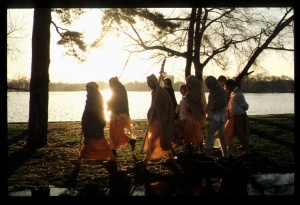CC Madhya 4.87 (1975)

A.C. Bhaktivedanta Swami Prabhupada
TEXT 87
- sakala brāhmaṇe purī vaiṣṇava karila
- sei sei sevā-madhye sabā niyojila
SYNONYMS
sakala brāhmaṇe—all the brāhmaṇas who were present there; purī—Mādhavendra Purī Gosvāmī; vaiṣṇava karila—elevated to the position of Vaiṣṇavas; sei sei—under different divisions; sevā-madhye—in rendering service; sabā—all of them; niyojila—were engaged.
TRANSLATION
All the brāhmaṇas present on that occasion were initiated by Mādhavendra Purī into the Vaiṣṇava cult, and Mādhavendra Purī engaged them in different types of service.
PURPORT
In the scriptures it is stated: ṣaṭ-karma-nipuṇo vipro mantra-tantra-viśāradaḥ. A qualified brāhmaṇa must be expert in the occupational duties of a brāhmaṇa. His duties are mentioned as six brahminical engagements. Paṭhana means that a brāhmaṇa must be conversant with the Vedic scriptures. He must also be able to teach others to study the Vedic scriptures. This is pāṭhana. He must also be expert in worshiping different deities and in performing the Vedic rituals (yajana). On account of this yajana, the brāhmaṇa, being the head of society, performs all the Vedic rituals for kṣatriyas, vaiśyas, and śūdras. This is called yājana, assisting others in performing ceremonies. The remaining two items are dāna and pratigraha. The brāhmaṇa accepts all kinds of contributions (pratigraha) from his followers (namely, the kṣatriyas, vaiśyas and śūdras). But he does not keep all the money. He keeps only as much as required and gives the balance to others in charity (dāna).
In order for such a qualified brāhmaṇa to worship the Deity, he must be a Vaiṣṇava. Thus the Vaiṣṇava's position is superior to that of the brāhmaṇa. This example given by Mādhavendra Purī confirms that even though a brāhmaṇa may be very expert, he cannot become a priest or servitor of the viṣṇu-mūrti unless he is initiated in vaiṣṇava-mantra. After installing the Deity of Gopāla, Mādhavendra Purī initiated all the brāhmaṇas into Vaiṣṇavism. He then allotted the brāhmaṇas different types of service to the Deity. From four in the morning until ten at night (from maṅgala-ārātrika to śayana-ārātrika), there must be at least five or six brāhmaṇas to take care of the Deity. Six ārātrikas are performed in the temple, and food is frequently offered to the Deity and the prasāda distributed. This is the method of worshiping the Deity according to the rules and regulations set by predecessors. Our sampradāya belongs to the disciplic succession of Mādhavendra Purī, who belonged to the Madhva-sampradāya. We are in the disciplic succession of Śrī Caitanya Mahāprabhu, who was initiated by Śrī Īśvara Purī, a disciple of Mādhavendra Purī's. Our sampradāya is therefore called the Madhva-Gauḍīya-sampradāya. As such, we must carefully follow in the footsteps of Śrī Mādhavendra Purī and observe how he installed the Gopāla Deity on top of Govardhana Hill, how he arranged and performed the Annakūṭa ceremony in only one day, and so forth. Our installation of Deities in America and in the wealthy countries of Europe should be carried out in terms of Śrī Mādhavendra Purī's activities. All the servitors of the Deity must be strictly qualified as brāhmaṇas and, specifically, must engage in the Vaiṣṇava custom of offering as much prasāda as possible and distributing it to the devotees who visit the temple to see the Lord.